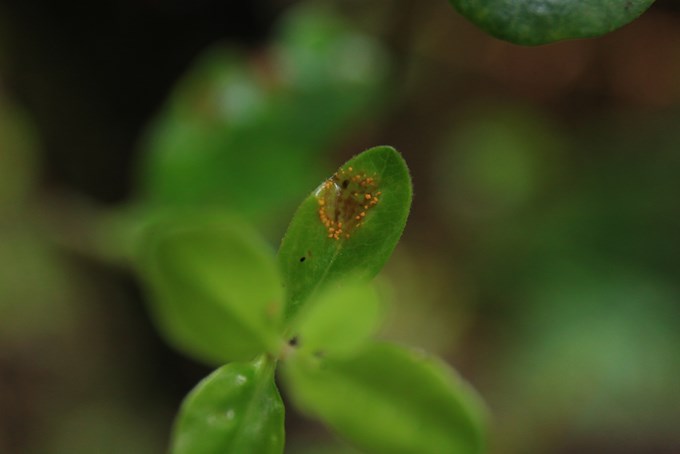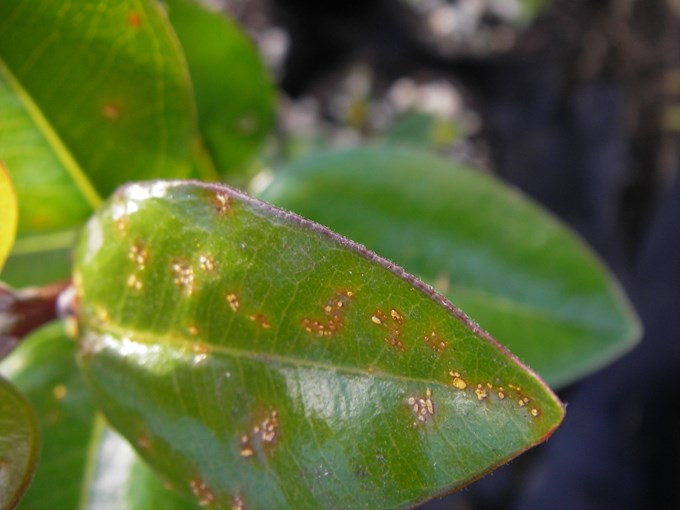The Ministry for Primary Industries (MPI) has confirmed two myrtle rust infections in south Auckland within the last month.
Myrtle rust, which attacks trees in the myrtle family, including pōhutukawa and rātā, was first detected in the Auckland region in November 2017.
Managing the disease
Three ramarama (Lophomyrtus) shrubs in Ōtara Creek Reserve, Ōtara, are infected with myrtle rust, along with a large number of ramarama shrubs in street gardens along Great South Rd, Manurewa.
Auckland Council Acting Head of Operational Management and Maintenance Simon Randall says action is being taken as soon as possible, with both sites having all the infected shrubs removed.
“We are working with MPI to develop our approach to the longer-term management of the disease across Auckland. This may include looking at what changes may need to be made to council operations such as planting programmes, resource consent requirements, field-work protocols, and so on in order to support the effort to minimise the impact of this disease.”
While people can accidentally move it around, the main way that the disease spreads is from spores that are carried on the wind.
The recent warm and stormy autumn weather has meant that containment has not proved possible and MPI has signalled the need to change gear and look to science for ways to manage the disease over the long term.
Public can help to curb spread of disease
Randall says the public can play their part by alerting MPI to further infected plants.
“The council will be increasing communications to ask the public to be on the look-out and report suspected myrtle rust through MPI’s phone line: 0800 80 99 66.”
The Ministry for Primary Industries (MPI) has led a yearlong response across the country and announced a shift to long-term management in April.
Auckland Council Biosecurity Manager Phil Brown says MPI has been working with Auckland Council and other regional councils and stakeholders, to develop plans to limit the impact of myrtle rust.
“From a practical perspective, this means that landowners will need to manage plants on their own properties in regions where the disease is well established, including across Auckland.
“MPI will continue to work on finding out how myrtle rust affects our natives, and we still want to know where myrtle rust is, so please continue to keep an eye out for any signs of the disease and get in touch with MPI to report it.”
Local board concerned by disease
Ōtara-Papatoetoe Local Board Chair Lotu Fuli says reports of the fungal disease being identified in the area are gravely concerning and she implores locals to keep their eyes peeled for further signs of the infection.
“Myrtle rust is a serious issue and we are happy that our Council whanau is working with MPI to promptly address it.
"We acknowledge that our Ōtara-Papatoetoe residents may be shocked and surprised to learn of this disease occurring in our own backyard and we ask residents to help by reporting any suspected sightings of myrtle rust in our local board area.”
What is myrtle rust?
Myrtle rust is a serious fungal disease that affects plants in the myrtle family. Plants in this family include the iconic pōhutukawa, mānuka and rātā as well as some common garden plants such as ramarama and lilly pilly.
As we enter winter, plant growth is slowing down and the weather is cooler, meaning we are less likely to see symptoms of myrtle rust.
What does it look like?
You’re most likely to spot myrtle rust on young, soft, actively growing leaves, shoot tips and young stems, as well as flowers and fruit.
Symptoms include powdery, bright yellow or orange-yellow spots, or brown-grey rust pustules in the case of older infections. The rust can appear red depending on the types of spores being produced.
The fungus may cause leaves to buckle or twist and die off.
What to do if you see myrtle rust:
Do not touch the plant as this may spread the spores.
If possible, take clear photos of the whole plant, the affected leaves, and a close-up of the spores or affected area of the plant and call the MPI Pest and Disease Hotline on 0800 80 99 66.
More information can be found on the MPI website.



